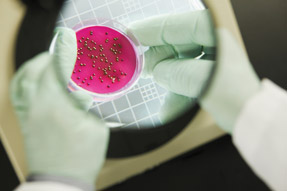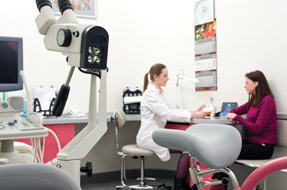Experts discuss crisis of antimicrobial resistance
Experts are looking at ways to prevent the world's next superbug before it actually causes an epidemic.
The time to worry about antimicrobial resistance is not when the world's been taken over by a superbug; it's now, according to experts who spoke at BIO 2015, a conference of the Biotechnology Industry Organization, held in Philadelphia in June.
“We're at the beginning of the postantibiotic era,” said Steve Solomon, MD, FACP, an infectious disease specialist, formerly director of antimicrobial resistance for the CDC and now principal for Global Public Health Consulting.

Concerning signs are already appearing, agreed Helen W. Boucher, MD, an infectious disease physician and associate professor at Tufts Medical Center and Tufts University School of Medicine in Boston.
“The most ominous thing I can share with you is we're now seeing patients with some regularity where we have to limit their medical options because of their resistant infections,” she said. “We've had cases where we've had to send people to hospice or where we've had to tell them that they can't have a heart transplant or a joint replacement because they have bacteria that we can't manage.”
In addition to dire warnings, experts offered challenges and potential solutions to fighting antimicrobial resistance during a panel discussion sponsored by Merck.
Scope of the problem
Microbes have been developing resistance since the invention of antibiotics, but several factors have caused the issue to become a particular problem now, said Dr. Solomon.
One is the speed with which patients move among countries and health care facilities. “Even if in your hospital, the infection control program is superb, if it's world class, you're constantly being threatened with the reintroduction of antimicrobial resistance and bacteria due to transfers,” he said.
Dr. Solomon offered carbapenem-resistant Enterobacteriaceae as an example. In 2000, it was seen only in North Carolina, but by 2015, it was in almost every state. “Over 15 years, that local spread became national spread, state by state,” he said.
Although some such tracking data are available, shortcomings in surveillance are another challenge in fighting antibiotic resistance. “We have patients who come to our hospital in Boston by all different routes. Without good surveillance even locally, we might not pick up the resistant bacteria they brought with them and therefore prevent giving it to the next patient,” said Dr. Boucher.
Surveillance of drug resistance serves many purposes. “We need to have better data to implement interventions, to evaluate those interventions, and, perhaps most of all, to motivate the kind of radical change that's going to be necessary if we're going to be successful in combating the spread of antimicrobial resistance,” said Dr. Solomon. “We have consistently over the years underestimated the impact in loss of lives, illnesses, and economic costs.”
Some worrisome estimates of the impact of resistance were offered during the session by economist Jim O’Neill, who recently completed a review of global antimicrobial resistance and is best known for coining the economic acronym “BRIC,” which stands for the economies of Brazil, Russia, India, and China.
Drug resistance is responsible for at least 23,000 deaths in the U.S. each year and 700,000 worldwide, according to the CDC. “By 2050, that could become 10 million. If that's not horrific enough, the economic cost, we have estimated, could be, between now and then, $100 trillion of global [gross domestic product],” Mr. O’Neill said.
His report also analyzed the state of antibiotic development and found that there's generally very little of it, particularly targeted at the most dangerous, highest-priority bacteria. “Of the things we really need, the pipeline is essentially empty,” said Mr. O’Neill.
Getting new drugs
Developing new antimicrobials seems like the most obvious solution to the problem of resistance, but there are a number of obstacles preventing, or at least slowing, this response, according to the experts.
“The easy targets have been targeted, and we're running out of low-hanging fruit in terms of finding new anti-infectives,” said Julie Gerberding, MD, FACP, former director of the CDC and now an executive vice president for Merck.
Then there's the money issue. “The main problem with antibiotics is just that fundamentally, economically they don't make sense for pharmaceutical companies. It's very hard to make money,” said Kenneth Hillan, MB, ChB, chief executive officer of Achaogen, a biopharmaceutical company.
It takes about 23 years on average for an antibiotic to become profitable, Mr. O’Neill reported. Current business pressures don't encourage pharmaceutical companies to take long-term risks like that, explained Dr. Gerberding. “The productivity of our research and development is under intense scrutiny, and we can't place the same bets that we used to be able to place even 10 years ago,” she said.
The limited funding for antibiotics is apparent in the labs, according to Mr. O’Neill. “It is also quite striking how few talented people research in the space, relative to other forms of medical research, and it's also striking that those that do get relatively low compensation,” he said.
The scientists also face a complicated regulatory environment, where different countries have different requirements for approval, adding scientific hurdles and burdening human and economic resources, Dr. Boucher said. Encouraging development of a harmonized global regulatory process would help with that problem, the experts said. Their solutions to funding antibiotic development were more varied.
The Orphan Drug Act might be a model, Dr. Hillan suggested, although he noted that market exclusivity may not always be an effective enticement. “If you have a drug that doesn't make money, when you extend the patent on it, it still doesn't make money,” he said.
To provide greater promise of profit from antibiotic development, Mr. O’Neill proposed a system of lump-sum payment to manufacturers successfully developing antibiotics that meet urgent clinical needs. His report calls for pharmaceutical companies to create an innovation fund for antibiotics, and it estimates the cost of getting 15 new drugs at $16 billion to $37 billion over a decade.
“We believe that for many reasons the pharma industry itself should be the one that finances that innovation fund, primarily because they are the ones that understand better than anybody else how you go from having a good idea to having a successful new drug,” he said.
The model for drug sales needs to change, added Dr. Gerberding. “We need to secure the reimbursement that gets us out of the bundled payment of the DRG [diagnosis-related group]. We have to do that in such a way where the patients who really do need the drugs get them, but in a way that does not incentivize people to use them when they shouldn't,” she said.
Doctors' role
Physicians need to take the lead in fighting resistance by not using antimicrobials when they're not necessary, the experts agreed. “Certainly, in the United States, the chokepoint for all antimicrobial use is physicians for humans and veterinarians for animals,” said Dr. Solomon.
As evidence of current medical overuse, he cited research showing that in the Mississippi Delta, 1,200 antibiotic prescriptions are written annually per 1,000 people, while on the West Coast, the rate is 300 to 400 per 1,000. “There is no hypothesis that says that people in the Mississippi Delta region need antibiotics at a rate 3 times that of people on the West Coast,” he said.
He offered anecdotal evidence, too. “One physician wrote to me, ‘Does it really make a difference if I write for a Z-Pak? How is that going to help the problem if I avoid writing that prescription?” Dr. Solomon said.
The answer is that in addition to the population-level risks of resistance, patients face individual risks of side effects, allergies, and negative impacts on the microbiome from unnecessary antibiotics. “The concept that these are no-risk-but-high-benefit drugs is incorrect, as we've seen over and over again,” said Dr. Solomon.
He added, “When [a physician's hand is] on that computer mouse and she's ready to make the click to prescribe an antibiotic, her thought process needs to incorporate the ideas of antibiotic stewardship and optimal prescribing right at that moment to write a prescription that protects the patient but doesn't harm society.”
To help physicians with that task, researchers need to develop systems providing real-time data on bacteria prevalence and better diagnostic tools, the experts agreed. Public awareness of the issue also needs to be raised, as antimicrobial resistance has had a relatively low profile among health care problems, they said.
“You go to your hospital and say, ‘I have this patient who has survived x and really wants to talk to the Boston Globe about it,” said Dr. Boucher. Instead of being pleased by the publicity, the administration may ask, “Did they get it at the hospital? Where'd they get it?” she said.
“We're going to try to put together some kind of collective global messaging program,” said Mr. O’Neill, describing plans to cover different social media platforms across the world.
Whether they're raising awareness, developing new drugs, improving prescribing, or tracking bacteria, working collectively will be crucial for everyone participating in the battle against antimicrobial resistance, the experts said.
“No 1 hospital can fight this alone. No 1 institution can address this problem, even in its own setting, without a more regional approach, without the involvement of all the other health care providers,” said Dr. Solomon.





